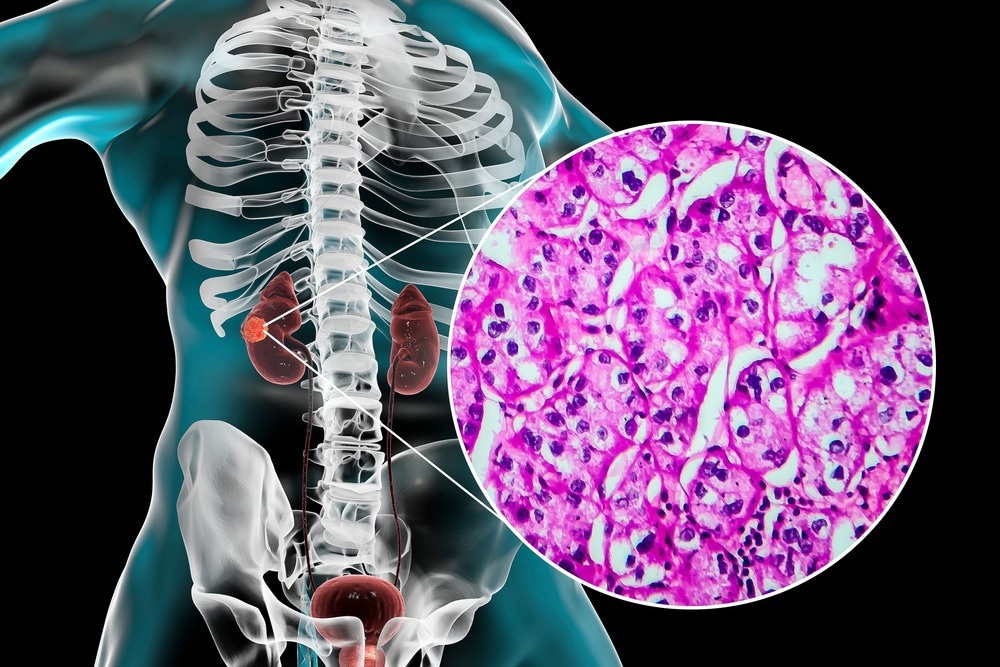In a recent study published in Cancers, researchers explored the association between the human microbiome and improved renal cell carcinoma (RCC) outcomes.
 Study: A New Treatment Landscape for RCC: Association of the Human Microbiome with Improved Outcomes in RCC. Image Credit: Kateryna Kon/Shutterstock
Study: A New Treatment Landscape for RCC: Association of the Human Microbiome with Improved Outcomes in RCC. Image Credit: Kateryna Kon/Shutterstock
Background
RCC is an immunogenic and highly vascularized tumor whose treatment strategy has been revolutionized with the introduction of immune-checkpoint inhibitors (ICIs). However, the therapeutic benefit of these medicines for patients with metastatic RCC (mRCC) is still limited. Researchers have recently focused on the microbiome as a therapeutic target and have obtained promising results. RCC treatment requires a comprehensive understanding of the tumor microenvironment (TME) microbiome.
RCC epidemiology, classification, and treatment
There are numerous subtypes of RCC, each with distinct histopathological and genetic features. The World Health Organization (WHO) categorization divides RCCs into three major histological subtypes: clear cell RCC (ccRCC), chromophobe RCC, and papillary RCC.
The standard treatment for patients having localized RCC is complete surgical tumor resection. Previously, patients diagnosed with metastatic disease were treated with cytokines like interleukin-2 (IL-2) and interferon-ɑ (IFN-ɑ) to stimulate the antitumor immune response. Tyrosine kinase inhibitors (TKIs), which include the mechanistic target of rapamycin (mTOR) inhibitors along with vascular endothelial growth factor (VEGF) antibodies, are commonly utilized as targeted medications and are regarded as anti-angiogenic treatments.
The proposed immunotherapeutic methods, ICIs, target and inhibit the cytotoxic T-lymphocyte-associated antigen 4 (CTLA-4), or T-cell receptor programmed cell death protein 1 (PD-1), to facilitate the restoration of tumor-specific T-cell immunity.
RCC and tumor microenvironment
TME comprises the surroundings of a tumor and consists of blood vessels, immune cells, the extracellular matrix, and fibroblasts. It offers the required elements for cancer invasion, growth, and angiogenesis. Effective cancer treatments depend on a medication combination that targets many TME components, like the vascular system that tumor cells feed on, and the immune system that responds against or assists the tumor cells and the cancer cells themselves.
In RCC treatment, it is crucial to assess the TME since it influences the therapeutic response. Current mRCC treatments aim to obstruct the growth of new blood vessels, or "angiogenesis," and to target the tumor cells.
Angiogenesis facilitates metastasis by encouraging the creation of abnormal neovessels that allow the entry of tumor cells into the bloodstream. These aberrant vascular networks affect the TME and create a hostile microenvironment defined by acidosis and hypoxia, which further help tumor angiogenesis and diminish the efficacy of anti-tumor therapies such as immunotherapy. This can be prevented by normalizing the tumor vasculature by restoring the balance between anti-angiogenic and pro-angiogenic variables, which can generate a hostile microenvironment, thus activating the immune system.
The microbiome and TME of RCC
RCC is the least investigated microbiome among genitourinary cancers. Some studies have revealed that a prior record of urinary tract infection of the kidney or the bladder was related to an elevated risk of RCC development, especially in males who smoke. This indicated the presence of complicated interactions occurring between bacteria and epidemiological risk variables in RCC. The study indicated that healthy kidneys as well as RCC tissues housed an abundance of specific microorganisms and that the microbiome considerably differed between malignant and benign tissues.
A study also revealed that Streptococcus, Blautia, Romboutsia, [Ruminococcus] torques group, and [Eubacterium] hallii group were prevalent and positively related with ccRCC. Streptococcus lutetiensis specifically enhanced ccRCC proliferation, invasion, and migration in-vitro through the TGF-signaling pathway, which may be a therapeutic target for RCC. On the other hand, another study observed that the species diversity in RCC tissues was notably diminished.
The study revealed that the proportion of 25 taxa rose and 47 taxa declined in RCC tissues compared to normal tissues. These included the order Streptophyta and the class Chloroplast which displayed a significant ability to distinguish between RCC tissues and normal tissues.
Microbiome and immunotherapy of RCC
The early diagnosis of small renal masses was correlated to a considerable stage migration of RCC at the time of presentation, while the introduction of novel therapeutics boosted RCC patients' life expectancy. Excluding the potential role of the microbiome in the development of RCC, studies have offered information on the sensitivity of RCC to various medicines, such as TKIs and ICIs.
ICI resistance was associated with poor immune regulation resulting from inherent or external factors, such as complex TME components and their connections with TME components. The studies also show that tumor-cell intrinsic variables that facilitate immunotherapy resistance included repression or expression of specific genes and pathways within tumor cells, like loss of tumor antigen expression, constitutive PD-L1 expression, and changes in the antigen-processing and presenting mechanisms that inhibit immune cell infiltration or role within the TME.
Conclusion
The study findings highlighted that the clinical usage of ICIs in patients with mccRCC provides limited survival advantages, and many patients developed ICI resistance. Other RCC types have displayed significantly lower response rates to ICIs. The researchers believe that predicting the patient response to ICIs and devising techniques to overcome ICI resistance should be the focus of future research.